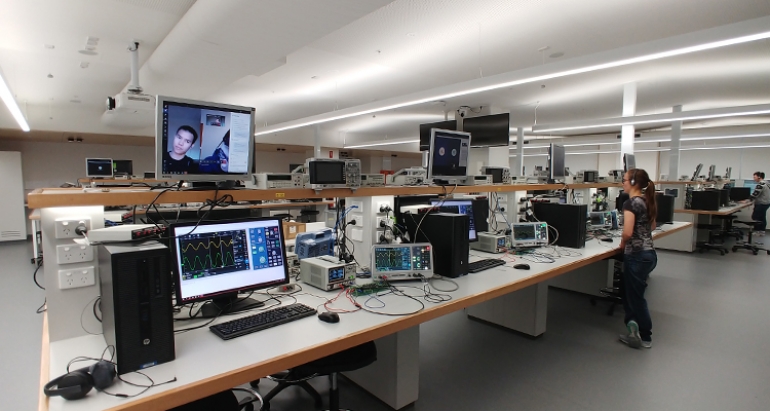Electrical Engineering students have been able to access the same hands-on lab experience while learning remotely thanks to their tech-savvy teachers.
With the arrival of COVID-19, teaching in the School of Electrical Engineering and Telecommunications (EET) had to be quickly and completely reimagined. The School had to find new ways to maintain the integrity of hands-on experimentation, pairing up with lab partners and conducting experiments with signal generators, robotic arms and oscilloscopes – vital practical experience with industry-standard equipment – even though students could not physically attend the lab.
It was during the initial transition to online learning that Zhenyu Liu, a senior technical officer, approached Dr. Arash Khatamianfar, an EET lecturer, to discuss an innovative idea: Could there be enough infrastructure already in place to develop fully remote laboratories for some of the EET courses?
By working together, Mr. Liu and Dr. Khatamianfar were able to develop a technique to bring the EET labs into their students’ homes virtually, with the support of Dr Chris Lu, a senior professional officer in EET. By configuring Microsoft Teams, the group was able to provide remote access to the EET lab computers. The usual teaching experiments were then set up so students could conduct the same tasks they used to do face-to-face, at home. The final step was to purchase and install webcams to provide a live video feed of the devices on lab computers, so students could see them working.
“I wanted to ensure that the laboratory component of our subjects serves our students’ learning, rather than merely following a prescriptive set of instructions. Students need to develop their own critical thinking and engineering design skills to be able to solve real world problems,” said Dr. Khatamianfar.
“By moving our lab equipment online using this new remotely accessible lab, I believe we’re helping students to develop these skills, despite this challenging time of social distancing and remote learning.”
The technical aspects of running remote labs using Microsoft Teams were a challenge for the team. Staff had to consider how they could create sessions for students to work in pairs, while each of them would have equal access to the lab computer, simultaneously being able to communicate with the lab demonstrator. A strategy was devised using Teams which created time slots very similar to the usual face-to-face style in an actual EET lab. In addition, by restoring the social aspect, albeit remotely, students felt more engaged and connected to the course.
As this new teaching technique was rolled out, Roy Zeng, another senior technical officer in the School, saw an opportunity for the same approach to be implemented on electronics lab equipment.
A crucial aspect for EET students in an electronics lab is to be able to apply different input signals to devices, be able to measure them in real-time and control the display of the data. EET’s advanced oscilloscopes have embedded signal generators and voltmeters, as well as special software which allows the user to control the features of the oscilloscope through a graphical user interface. Mr. Zeng realised that this feature could be integrated into the new remote lab teaching technique so that students could operate remotely and have the same experience on the oscilloscopes as if they were in the lab. Thanks to the innovation and teamwork of the EET staff, including Dr. Aron Michael and Dr. David Tsai, students have been able to receive a robust remote lab experience, very closely resembling what they would have experienced on campus.
Through this experience, the staff at EET have learned a lot about the possibilities of Microsoft Teams and its integration into course design and laboratory equipment. By working collaboratively, the team has been able to explore different teaching and education technologies and how they can be adapted to improve the quality of students’ education, and give them that vital lab-based experience, by using technology and tools already in place.
This article was first published in Inside UNSW on 14 July 2020.
